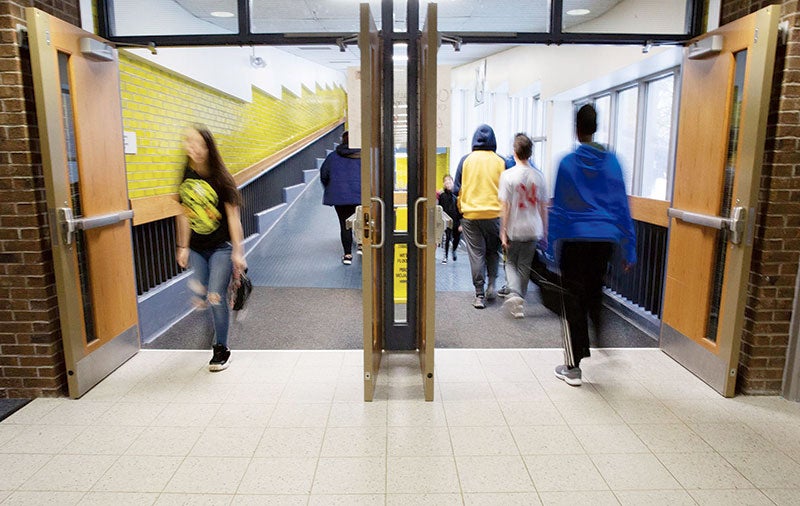Minnesota researchers say we’re still getting school safety wrong
Published 8:03 am Thursday, March 28, 2019

- Fire doors used throughout Oak Grove Middle School are equipped with locks and magnets, allowing them to swing shut to create barriers for intruders. Christine T. Nguyen/MPR News
By Elizabeth Shockman
MPR News/90.1 FM
“It’s been 20 years. This is not working.”
That’s Jillian Peterson’s blunt assessment of the nation’s reactions to school shootings since April 20, 1999, when two students opened fire inside Colorado’s Columbine High School, killing 13, wounding 20 and destroying the belief in school as an oasis from gun violence.
Policy makers have spent billions of dollars since then on equipment to “harden” schools and on consultants to train kids to hide in place, but the deaths haven’t stopped. Parkland, Sandy Hook and Red Lake are names as sadly familiar as Columbine; 2018 was a record year for deaths with 56 people killed in school shootings.
With the 20-year anniversary of Columbine approaching, Peterson, a Hamline University criminology professor, believes the nation needs to rethink the way America approaches school safety.
She and her colleague James Densley, a criminal justice professor at Metropolitan State University, say their research suggests the conventional wisdom on responding to these killings is wrong, and that a very different approach to school safety is needed.
“You can’t stop something or prevent something from happening until you really understand why it’s happening,” Peterson said. “We’ve now hit a point where it’s happened enough that we can actually start to create data and draw conclusions and use research to come up with policy … our data gives some theory as to why it’s not working.”
Peterson walked MPR News through data she and Densley have collected, and the conclusions she said can be drawn about what works and what doesn’t in school safety.
The researchers built a database of 160 mass public school shootings in the United States since 1966. They focused on the 45 of those shootings that have occurred in schools since Columbine.
Peterson said there’s no single profile of a school shooter but there are patterns among those who have committed mass acts of gun violence at schools.
• 91 percent were current or former students of the school where the shooting took place.
• Many had a history of trauma and risk factors for crime and violence.
• 80 percent had expressed suicidal thoughts and had signs of a crisis before the shooting.
These patterns, combined with the increasing severity of mass school shootings, suggest to Peterson that the way America is trying to prevent school shootings is simply not working.
“We’re really focused on security in schools — running lockdown drills, watching training videos, resource officers in schools,” she said. “In Minnesota, we put a lot of money into building more secure buildings, more secure entry points … we know that it’s inadequate. It’s not preventing school shootings.”
‘Script for violence?’
Lockdown drills top the list of security measures Peterson believes schools need to drop. She thinks training the adults in school on lockdown procedures, de-escalation and suicide prevention should happen without involving the kids.
The drills, she said, traumatize many students, and since most shootings come at the hands of current or former students, the routine may unwittingly offer a would-be shooter a blueprint on how to increase casualties.
“Are you handing a script for this type of violence at a really young age? Are we giving this to kids and training them on it … sort of triggering a fascination in vulnerable kids when we’re having them rehearse this over and over and over again?” Peterson asked.
Minnesota law requires schools to run students and staff through five lockdown drills a year, meaning most Minnesota children will have rehearsed lockdowns more than 70 times by the time they graduate. Nationally, the Washington Post found more than 4 million children across the U.S. ran lockdowns last school year.
Some are “shelter in place” drills or “flee drills.” There are reports of schools holding “live action” or simulation drills, where they might employ the sound of gunfire, props or other dramatizations to simulate drills.
Sometimes students are not told that drills are just a simulation and not an actual event. That goes against recommendations from the National Association of School Psychologists, which also suggests making special accommodation for children with a history of trauma or anxiety.
University at Buffalo professor Amanda Nickerson helped write the school psychologist guidelines and co-authored a study on the psychological effects of lockdown drills. She said her study found drills, as long as they’re done properly, don’t harm children and didn’t change their perceptions of school as a safe place to be.
‘What do you need?’
In Minnesota, parent Erin Preese said she’s seen the drills affect her children.
One time she found her daughters, then in preschool and kindergarten, huddling with their stuffed animals in a corner at home. They said they were having a lockdown drill, and, shocked, she watched them warn each other about a “bad guy” moving from classroom to classroom. Preese said her kindergartner didn’t know whether the lockdowns were real or not when they happened.
“She was sitting there in her kindergarten classroom on the floor, thinking that there was a real gunman in her hallways coming to shoot her. And that just breaks my heart because kids should feel safe at school,” said Preese, who also teaches at a suburban Twin Cities elementary school and has pushed for new gun control measures at the Capitol with the group Moms Demand Action.




